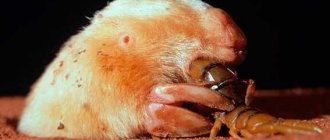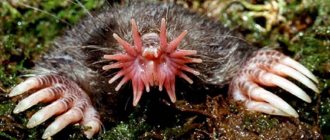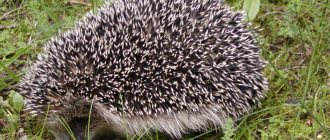- Wild animals
- >>
- Mammals
The marmoset is an unusual little monkey that lives in tropical forests. They are distinguished from other representatives of monkeys by their size - they are the smallest primates in the world, which can fit on a human finger. These are fluffy animals with a harmless character and cute appearance.
Appearance and features
Photo: Tamarin monkey
The body length of one adult individual ranges from 19 to 35 centimeters. Primates have a very long tail. Its size is almost equal to the size of the body and ranges from 20 to 40 centimeters. Regardless of the subspecies, its representatives differ from other monkeys in their bright and unusual appearance and unusual combination of colors. The animals have very thick and soft fur. Its color can be very diverse.
Characteristic color for small primates:
- yellow;
- white;
- black;
- lactic;
- brown;
- various shades of red;
- honey;
- gold and its various tones.
A characteristic feature of this particular type of primate is the amazing combination of all kinds of color variations. Some individuals and subspecies have very clearly defined eyebrows, nose contours, mustaches, beards, “toes on legs,” etc. There are representatives of individual subspecies that have such an unusual combination of colors that from a distance they are often mistaken for unusual outlandish birds.
Depending on the subspecies, the monkeys’ faces are completely devoid of vegetation or, conversely, completely covered with hair. The average body weight of one adult individual is 300-400 grams. Most subspecies of this species are distinguished by a predominance of black color. It is worth noting that this color is characteristic not only as a coat color, but also as a skin color.
Who are these marmosets? Description, types, price and conditions of detention
Many people dream of owning an exotic pet. Recently, many fans of small monkeys – marmosets – have appeared among breeders. These are amazingly smart and cute animals. Like any pet, the marmoset requires special care. What should you know about this monkey before getting one?
Description
Marmosets are the smallest primates of the marmoset family. They are often called “pocket monkeys” for their tiny stature and active behavior. The weight of an adult reaches 100 grams, and the height ranges between 20 and 25 centimeters.
Marmosets have a very long tail, which serves them only as decoration, without performing any functions. The typical color of the monkey is reddish-dark. Black or white specks may be present. A distinctive feature of marmosets is their round, slanted, but expressive eyes and only 2 teeth in the jaw apparatus.
Interestingly, the monkeys’ limbs allow them to jump 5 meters.
What does a marmoset eat?
Marmoset: the smallest monkey
Photo: Marmosets
Marmosets are primarily herbivorous monkeys. But they can make up for the lack of protein with animal food. The difficulty is that a monkey that wants to snack on some small animal risks becoming its food itself.
The diet of marmosets often includes:
- berries;
- fruits;
- plant flowers, including pollen, which they love for its sweet taste;
- young shoots, green leaves;
- wood beetle larvae;
- moths, crickets, other small insects;
- amphibian fry.
Marmosets have a great need for water because, for their small size, they are very energetic and are always on the move. To avoid going down to streams and other land-based sources of water, monkeys drink dew and water that accumulates in tree leaves after rains.
Marmosets have strong incisors - these are their only two teeth. Thanks to them, they can bite through the upper layers of young bark, extracting nutritious tree sap. Their small paws allow them to easily remove worms from crevices in old tree trunks.
In terms of nutrition, marmosets have no competitors in the form of other monkeys; they are very small and light, which allows them to easily climb to the very tops of trees and feed on fresh fruits, where heavier monkeys cannot climb.
Now you know what to feed the little marmoset monkey. Let's see how she lives in the wild.
Where does the marmoset live?
Photo: Marmoset monkey
Pocket monkeys live in the following places:
- South America;
- Brazil, where they were first discovered;
- Bolivia - Amazon basin;
- Peru;
- Ecuador.
Due to their small size, monkeys are forced to constantly hide, so their main habitat is the highest tree crowns, where there are as few predators as possible. To spend the night, marmosets choose tree hollows and stay in numerous flocks of families, in which there are up to six generations.
Marmosets rarely descend to the ground, because there they face a lot of dangers. But these creatures are curious, so they can often be seen near villages and other small settlements. They willingly come down to people and can settle near their homes. Black-eared marmosets are especially friendly.
Marmosets are heat-loving animals that prefer an air temperature of at least 25-30 degrees. At lower temperatures, monkeys quickly freeze and may die from hypothermia, since their bodies are designed to live in the tropics.
Air humidity is also important for marmosets, which should reach at least 60 percent.
Social structure and reproduction
Cynomolgus macaque: keeping at home
Photo: Baby marmosets
The marmoset family includes females and males of all ages. Monkeys do not have a clear hierarchy, they do not fight for position in the pack, unlike the same baboons, but marmosets have a clearly defined leader who fertilizes most of the females in the family.
The male reaches sexual maturity at 3 years, the female at 2 years. The female chooses her own male, but most often her choice falls on the potential leader - the largest and hardiest male. Since marmosets live in warm climates, they do not have a mating season or mating displays.
Pregnancy lasts about five months, as a result of which the monkey gives birth to one or two cubs weighing no more than 15 grams. Children cling tightly to their mother's fur with their claws and travel with her on her stomach, feeding on her milk, and then on her back, picking off young shoots and soft leaves.
Children are raised collectively. Both males and females treat the young generation with care, carry them on themselves, and comb their fur. The main male of the flock is mainly busy searching for suitable places for feeding and looking out for possible danger.
At three months, children move independently, and by six months they can eat the same food as adults. Monkeys go through puberty; Just like in humans, female marmosets begin to mature earlier - at the age of one year, while males - at one and a half years. During this period, marmosets may mate, but not produce offspring.
Silver marmoset
0
— Body length: 22 centimeters. — Weight: about 350 grams. The fur color of the silver marmoset ranges from silver to brown. The tail is black and grows up to 29 centimeters. They live in large family groups of about 12 individuals. Within a group there is a dominant and a subordinate. Only the dominant female produces offspring; the rest do not participate in reproduction. The female gives birth to no more than two cubs. After six months, they already switch to adult food, and at the age of 2 years they are considered independent and adult individuals. For the entire six months, when the cub feeds only on mother’s milk, the male takes care of it and carries it on his back.
Cost of different types
Brown capuchin
Lion marmosets
Brown capuchin (lat. Sapajus nigritus) the weight of an adult animal can reach 6 kg, body length 30-35 cm, tail 30-56 cm. Males are larger than females. They are considered the smartest monkeys of the New World. These monkeys are easy to keep in captivity and, with proper care, can live up to 50 years.
Price: 160,000 – 180,000 rub.
Saymiri squirrel
These small and smart monkeys are considered one of the calmest and non-destructive when kept at home. The size of saimiri is small. Body length 26-36 cm. Tail length 35-42 cm. Weight approximately 750-1100 g.
Price: 110,000 – 130,000 rub.
White-eared marmosets
Ordinary marmosets or marmosets are charming small monkeys. Body length with head - up to 20 - 30 cm, tail length up to 40-50 cm. Weight: 250-320 g, males are slightly larger than females. Life expectancy is 10 years in captivity up to 16 years.
Price (average): 85,000 – 90,000 rubles.
Approximate prices based on recent listings:
- baby marmosets available in St. Petersburg – 80 thousand;
- male white-eared marmoset 2 years old from owners in Sochi – 50 thousand;
- marmoset in Kemerovo without the possibility of shipment - 80 thousand;
Red-armed tamarin
The red-handed tamarin (Saguinus midas) is a species of marmoset monkey from the genus Tamarin. The body length is from 21 to 28 cm, the tail is from 31 to 44 cm long. Weight is from 400 to 550 g. Life expectancy is 10 - 15 years. The red-handed tamarin is an omnivore and is active during the day. The main diet is fruits, insects, nectar and tree sap.
Price: 85,000 – 95,000 rub.
Cynomolgus macaque
The Javan macaque is one of the most common macaques both in circus training and in home keeping. Medium sized monkey. Body length is from 40 to 60-65 cm. The weight of an adult male is 4 - 8.5 kg, females 2.5 - 3.8 kg.
Price: 165,000 – 180,000 rub.
Dwarf marmoset
The pygmy marmoset (lat. Cebuella pygmaea) is a species of primate from the marmoset family (Callitrichidae). It is one of the smallest representatives of the entire order of primates. Their size is only from 11 to 15 cm, not counting the tail, which is from 17 to 22 cm long. The weight of dwarf marmosets is from 100 to 150 g.
Price: 80,000 – 90,000 rub.
Green monkey
Green monkeys are small representatives of the Old World monkeys; these monkeys were known in ancient Egypt. Body length with head 57-71 cm, tail 30-48 cm, weight: females 2.5-3.5 kg, males 5-7.5 kg. Life expectancy in captivity is up to 45 years.
Price: 145,000 – 160,000 rub.
Black lion marmoset
0
— Body length: 25-24 centimeters. — Weight: about 500-600 grams. These monkeys are completely black except for their red buttocks. There is a thick mane around the head. Their muzzle is flat and hairless. The tail can reach 40 centimeters in length. Black lion marmosets live for about 18 years. However, recently their numbers have decreased significantly. They have been given the status of “endangered”. The habitat of these monkeys is gradually being destroyed, and poachers are hunting for individuals.
Features of character and lifestyle
Photo: Lion tamarin
Animals love to climb various trees and bushes. They spend most of their time at different altitudes. Small monkeys are diurnal animals. They wake up with the first rays of the sun and are very active during daylight hours. As soon as the sun begins to set, they go to bed, choosing the most comfortable place on tree branches or vines. A long tail helps tamarins move from branch to branch and hang on vines. It also serves as a balancer during jumping.
Tamarins do not tend to lead a solitary lifestyle. They live in groups. The number of one family or group ranges from five to twenty individuals. Monkeys are very lively, playful and active animals. They actively communicate with each other using facial expressions, various poses, and ruffling of fur. Primates also tend to produce a variety of sounds. They can chirp like birds or whistle, sometimes hiss or squeak. If they sense the approach of serious danger, they emit loud, very shrill screams.
Each family has a leader - the most mature and experienced female. The task of males is to provide food for themselves and their family members. Each family occupies a certain territory, which it fiercely defends when strangers appear. Individuals of each clan mark their territory by gnawing the bark of trees and bushes. Even small tamarins are very jealous of protecting their territory. Often they also get into fights for their territory, using sharp claws and teeth. Tamarins spend a lot of time cleaning the fur of their relatives. This pastime allows you to get rid of parasites and gives a relaxing massage.
Geoffroy's Marmoset
0
— Body length: 20 centimeters. — Weight: about 190-250 grams. They have incisors with which they gnaw through the bark of trees in search of tree sap. During the rainy season, they spend most of their time resting and getting food, but during the drought they are very active. When it comes to food, Geoffroy's marmosets are unpretentious. Their diet includes insects, fruits, plants and tree sap. They live in large groups (8-10 individuals) with one dominant pair. The cubs are cared for by all members of the group until they are 18 months old. Then they become independent.
Health problems in marmosets
Veterinary surgeons require special training to work with marmosets. Not all veterinary surgeons have received this training.
Find a veterinary surgeon before you actually need one.
Household Inspection: Marmosets should be checked at least twice a day, looking for changes in behavior, lack of activity (marmosets are still longer than usual and less attentive), any substances coming out of the nose or eyes, and diarrhea. An infant who falls to the floor (and is not picked up by other group members) should be carefully assessed for injury or illness.
Other signs of the disease:
- Weight loss,
- The coat appears dull or shows signs of lack of care,
- The monkey sits separately from the others,
- Hunched posture.
Symptoms requiring veterinary consultation:
- Any abnormal behavior or other signs of ill health continue,
- The marmoset stays in a box or other hiding place, does not eat/drink, and lacks energy for a long time,
- Abnormal behavior.
What is known about the Callimico lifestyle
Callimicos live near the Amazon River, in the rain forests. Their home is the dense crowns of trees. They move and scream like marmosets and tamarins.
Callimico geldiaceae was described in 1904, but after that little was learned about the biology, habits and ecological features of the species. To date, the range of these monkeys has not even been precisely determined. A few specimens have been captured in western Brazil and eastern Peru. In these places, monkeys live in groups of 20-30 individuals. It is very difficult to catch active and intelligent callimicos.
Callimico geldium is on the list of protected species.
Lifestyle
The smallest monkey on the planet is especially active in the morning and afternoon. They walk on four legs. In trees they use claws to hold position. They can move along vertical branches. They jump at a distance of about 4 meters, can swing on long branches and vines, and thus move from branch to branch.
Marmosets are sociable and interact with each other constantly, throughout the day. Their language has many sounds that express certain circumstances: chirping, trilling, and even sounds beyond the audibility of the human ear.
These monkeys live in packs founded by one pair. There can be up to four generations of offspring in a flock. It is not known for certain whether they lead a monogamous or polygamous lifestyle. It is likely that this is individual for each flock. In social relations, caring for the fur of fellow tribesmen plays an important role.
They do not have a breeding season. The female bears the offspring for about 4.5 months; as a rule, twins are born, less often triplets. Within six months after giving birth, the female will be ready for another pregnancy.
Newborn babies weigh only 16 grams. However, relative to the mother's weight, this is one of the largest indicators in primates - 1/6 of the mother's weight. Babies are completely helpless and need care. The role of nannies is taken on by other members of the flock. They carry their cubs on their bodies and bring them to their mother only for feeding. After just 3 months, the babies are ready to live independently, but remain with their family.
Flocks live in territories of up to 0.4 square kilometers. They mark their areas with scent and can protect them from other flocks. Sometimes there are fights, but mostly only threats.
The main threat to the life of these little monkeys is attacks from predatory snakes and birds. Pet trading is also common on them.
Golden lion marmoset
0
— Body length: 20-25 centimeters. — Weight: about 900 grams. This is the largest monkey of the marmoset family. Its tail can grow up to 37 centimeters. The golden lion tamarin gets its name from its resemblance to a lion. Around the monkey's head there is fur like a mane, which glows golden in the sun. All wool shimmers beautifully in the sun's rays and is therefore compared to gold dust. Marmosets take care of their appearance and always take care of their fur. They live mainly in groups of 3 to 8 members.
Population and species status
Photo: Marmosetka
In Brazil, the marmoset has the status of a protected national species, and their removal from the territory of the country is prohibited by law. This is because marmosets are being sold on the black market as pets, and can sometimes fetch up to $100,000.
However, marmosets are not an endangered species. They readily reproduce at home. The black market for the sale of monkeys is especially widespread in China. The marmoset population is also declining due to deforestation, but still remains quite large. In Russia, marmosets can be legally purchased from breeders and through various websites. Their maintenance and nutrition entail huge expenses, so not many buyers can afford this pet.
Marmosets are caught individually, which determines their high price. You can catch a monkey only by luring it to lower trees with the help of treats - the monkey willingly goes into a cage or other similar structure, which then slams shut. Wild monkeys are not sold, but prefer to receive offspring from them that will be fully accustomed to humans.
Marmoset nurseries are common in South America. Often these monkeys are not difficult to catch, since they themselves willingly make contact. Marmosets have no commercial significance; they are not shot for sport and are not pests.
The marmoset is an unusual representative of monkeys. She managed to gain popularity among people due to her cute appearance, friendliness and cheerful habits. These sociable animals are adapted to live in the tropical jungle, so keeping a monkey at home, even in ideal conditions, means depriving the individual of a family and important social connections.
Tags:
- Callimico Miranda
- Callimico Miranda Ribeiro
- Callithrichinae
- Euarchonta
- Euarchontoglires
- Deuterostomes
- Bilaterally symmetrical
- Amazon Animals
- Animals of Bolivia
- Animals of Brazil
- Animals of Colombia
- Animals starting with the letter M
- Animals of Peru
- Animals of the Subtropical Zone of the Southern Hemisphere
- Animals of the Subequatorial Belt of the Southern Hemisphere
- Animals of the tropics
- Rainforest Animals
- Animals of the Tropical Zone of the Southern Hemisphere
- Animals of the Temperate Zone of the Southern Hemisphere
- Animals of Ecuador
- Animals of the Equatorial Belt
- Animals of South America
- Animals
- Small animals
- Cute animals
- Unusual animals
- Unusual animals of the world
- Unusual animals of the planet
- Apes
- Monkey
- Placental
- Vertebrates
- Primates
- Primates
- Herbivores
- The smallest animals
- The most unusual animals
- The most unusual animals in the world
- The most unusual animals in the world
- Unique animals
- Chordates
- Grain-tailed monkeys
- Ghostostomes
- Quadrupeds
- Broad-nosed monkeys
- Eukaryotes
- Eumetazoans
Tiny marmoset
0
— Body length: 18 centimeters. — Weight: about 150-180 grams. The coat color is mainly olive-brown, with golden-yellow or gray-yellow on the belly. Most often found in the Amazon rainforest and Brazil. In total there are about 10 thousand individuals. The tail is up to 23 centimeters long, completely black. The ears and face are mostly hairless, but there is a large tuft of hair on the head by which this species of monkey can be easily distinguished. The tiny marmoset is not as common as the pygmy marmoset, but they are still often kept as pets.
Marmoset
The next smallest monkey in the world is Geldi's marmoset, or by another name, Geldi's callimiko from the Marmoset family. This closest relative of the pygmy marmoset is even called “pocket”, because this definition perfectly describes its modest size. The marmoset, reaching only 22 cm in length and 100-300 g in weight, can really fit comfortably in your clothing pocket! The only thing that will stick out from there will be its tail, which grows to 25-30 cm.
Usually this smallest monkey is colored in smoky brown shades with dark or light elements, however, in some individual subspecies the coat color may be different - unusual and unique. For example, the body of silver marmosets is white, and therefore their hairless muzzles and peach-pink ears stand out especially clearly. Golden marmosets have the tips of their ears decorated with white tassels, and the body itself has a reddish-yellow tint and yellow rings on the tail. Black-eared marmosets have tufts of dark hair on their ears, and the overall color is formed by alternating black, gray and brown stripes. All species have a developed brain, only 2 teeth and slightly slanted eyes.
Heldium callimiko is an active and social creature. The flock includes from 5 to 13 individuals, among which the dominant pair always stands out - the dominant male and female. The families themselves are generational, and all the marmosets within them are connected by family ties. Communication with relatives is characterized by harshness, impetuosity and emotionality. Thus, these animals use up to 10 types of squeaks, clicks and other sounds to express their state. Despite this, marmosets are not aggressive, so even fights that occur between males usually end with calls.
In its natural habitat, the marmoset can be found in South America, but seeing the nimble, cautious and timid creature will not be easy, because for the sake of safety, tiny animals climb as high as possible onto tree branches. For climbing, they have well-developed limbs, strong fingers and sharp claws
Despite its miniature size, the marmoset is capable of jumping up to 5 meters in height! With the onset of dusk, callimicos hide in hollows so that they are not inadvertently eaten by a snake or some predatory night bird. However, even when an enemy appears, the marmosets are ready to give him a worthy rebuff together.
Heldium callimicos are awake during the daytime, and most of the time is spent eating food. The daily diet includes some flowers, leaves, fruits, as well as insects, bird eggs and small amphibians (small frogs, salamanders, etc.). To drink, the monkey uses either dew accumulated on the leaves of plants, or, in times of drought, sap from tree trunks, which it sucks out thanks to its sharp incisors. The marmosets spend the remaining time resting. This is how callimicos live for about 10 years. In captivity, life expectancy can increase to 13-16 years.
Area, distribution
These animals live in the same place as most primates - in the territories of Ecuador and Peru. Also in the jungles of Brazil, Bolivia and South America. Their homes are located away from the paws of terrestrial predators, as high as possible in the trees.
Marmosets spend the night in tree hollows. Pygmy monkeys live in crowds. Groups of their settlements can consist of five generations of the same clan. These are family settlements.
Return to content
Natural enemies of marmosets
Photo: Marmosets
The yellow, green and brown pigments of marmosets provide them with camouflage in their forest habitat. In addition, monkeys have developed means of communication to warn each other about impending threats. However, their small body size makes them potential prey for birds of prey, small cats and climbing snakes.
Known predators that attack marmosets include:
- birds of prey (falconiformes);
- small cats (Felidae);
- tree-climbing snakes (Serpentes).
It appears that the biggest role these tiny primates play in their ecosystem is related to their basic feeding mechanism, so they may influence the health of the trees they feed on. Larger, competing primates that also feed on exudates may drive groups of smaller marmosets out of a tree to take advantage of previously drilled holes. With the exception of such interactions, contact between C. pygmaea and other primates generally occurs without complications.
Ants can enter drilled holes in trees, so marmosets are forced to relocate. Pygmy marmosets are susceptible to the parasite Toxoplasma gondii, which results in fatal toxoplasmosis. There is limited data on the lifespan of wild marmosets, however, birds of prey, small cats and climbing snakes are common predators.
Natural enemies of marmosets
Photo: Marmoset monkey
Due to their habitat, marmosets are protected from most predators that pose a danger to other monkeys. In particular, the main enemy of monkeys is wild cats, which simply cannot climb to the same height as marmosets. Many large birds are not interested in marmosets due to their size.
But they still face the following predators:
- boa constrictor;
- bushmaster;
- coral adder;
- vultures;
- harpies;
- urubu;
- margay cat;
- Brazilian travel spiders;
- Andean condor;
Most often, monkeys are attacked by birds. Being on the tops of trees, marmosets can lose their vigilance and calmly feed on fruits and leaves when a large bird of prey swoops down on them. Harpies and vultures are very swift, so it is not difficult for them to get close to the monkeys unnoticed and quickly snatch prey for themselves. Although, as a rule, these monkeys are too small prey for large predators.
Another danger for small monkeys is snakes that hide in dense foliage. Often marmosets themselves come too close to the snake, not noticing the danger due to their camouflage color. Most snakes will have no problem swallowing a marmoset without first strangling it. Some particularly large spiders prey on baby marmosets. Poisonous spiders and snakes pose a particular danger to these monkeys.
If marmosets notice an enemy, they begin to scream subtly, notifying their fellows of the approach of a predator. After this, the monkeys scatter, which disorients the predator, preventing it from choosing a specific victim. Marmosets are not capable of self-defense, and even if a baby is in danger, no one will rush to save it. Monkeys rely entirely on their small size and ability to run fast and jump far.
Habitat and lifestyle
Marmosets are monkeys primarily found in South America, Brazil, Bolivia, Peru and Ecuador. They settle in the crowns of trees, thereby protecting themselves from inhospitable predators. They live in a family-like society and can be united by several generations.
Marmoset monkeys communicate using sounds similar to chirping and chirping. In their “dictionary” there are at least 10 signals that they focus on during “negotiations”. Marmosets - which is atypical for primates - do not mark their territory, do not become attached to it, and do not defend it.
Such monkeys give birth to offspring twice a year. It is unusual that newborn marmosets are in the care of the male, and only meet their mother when feeding occurs.
In the wild, these primates can live 10 years. For a domestic marmoset, with proper care and maintenance, this period is often longer.
The lifestyle of marmosets allows them to hide from attacks by land animals. But birds and some animals pose a huge threat to monkeys. The main danger is still humans: he destroys their habitats and is engaged in illegal capture of primates.
The marmosets' schedule spends most of their time resting and exploring the territory. Based on observations, we can say that these are the main activities in the life of monkeys. In addition, the monkeys stock up and play a lot. Relaxing with the marmosets is not quite a vacation in the human understanding. At this moment, the monkey examines objects and animals and takes a closer look at its relatives.
Marmoset - a small monkey: description and types, content, how much it costs
The beauty and diversity of the animal world has not bypassed such a family of animals as primates. In the world there are not only representatives who are distinguished by great height, weight and strength, but also very tiny ones. The marmoset is one of the smallest representatives of the marmoset monkey family. It will be discussed in this article.
Representatives of this species of pygmy marmosets are called pocket monkeys for their modest growth and enviable activity.
The weight of an adult monkey is about only one hundred grams with a height of 20–25 centimeters. The tail reaches a length of 20–25 centimeters. It may seem that the long tail has a grasping function, however, this is not the case.
The standard color of pygmy marmosets is reddish with a dark undercoat, which may have black or white splashes. The marmoset's skull is small, but the brain is quite developed.
To control the environment, nature has endowed monkeys with the ability to turn their heads up to 180 degrees. The monkey's eyes are expressive, round with a slight slant. A monkey has only two teeth.
Developed five-fingered limbs allow marmosets to jump up to five meters in height, and sharp claws allow them to firmly grasp and attach to tree trunks or branches.
Types of Marmosets:
- Silver. The most common. It is distinguished from others by its color, which has whitish (silver) hairs.
- Golden. It is similar to the silver one, however, it has a yellowish body color and yellowish rings on the tail. The ears have white tassels.
- Black-eared. It gets its name from the black tufts of hair on its ears. The color of the monkey's body alternates with black and brown stripes. Black-eared marmosets settle near humans much more often than other species.
Habitat and lifestyle
Like most primates, these pygmy monkeys live in South America in the jungles of Brazil, Bolivia, Peru and Ecuador.
Monkeys live in the dense crowns of trees, higher up from terrestrial predators. Pygmy marmosets spend the night in tree hollows. Marmosets are social animals and live in large groups that are built on the family principle, i.e.
representatives of one family live in one group, which can consist of 4–5 generations. Female pygmy marmosets give birth twice a year. The protection and upbringing of the babies falls entirely on the male, who gives the babies to the females only for feeding.
In the wild, monkeys live up to 10 years; in captivity, with proper care, this period increases by 2–3 years.
The constant temperature for keeping marmosets should range from 25–30 degrees Celsius. Humidity of at least 60% is considered normal.
The diet of pygmy marmosets is varied and consists of:
- a variety of fruits;
- flowers and leaves of plants;
- insects;
- bird eggs;
- amphibians.
The monkey quenches its thirst with water that accumulates on the leaves of trees. Thanks to their powerful incisors, marmosets can extract tree sap, and their low weight allows them to reach fruits that other heavy competitors cannot eat.
Reproduction and the first year of life of marmosets
Fertility of females begins at two years of age. The female chooses her future father herself. Pregnancy of marmosets lasts 140–150 days. Usually two or less than three cubs are born.
At birth, babies weigh about 12–15 grams. Babies spend the first 2–3 months with their mother, feeding on breast milk. After which they pass into the power of their father until they finally get stronger.
From three months they can move independently, and from six months they begin to eat the same food as adults. Puberty begins at 12 months and ends at two years.
Threats to life
By choosing to live on branches, marmosets got rid of ground-based dangers , such as attacks from large cats.
However, attacks by birds of prey and tree snakes are very serious, and if monkeys fight predators through their social structures, they cannot protect themselves from human intervention.
It is man who is the main enemy of marmosets. Habitat destruction and illegal trapping are the current problems facing the little monkeys.
Price
If you have firmly decided to place this cute animal in your home, the most reasonable question arises: how much does a marmazette cost and where can they be purchased? Most often, marmosets are purchased either at a specialized pet store or directly from the breeder through message boards on the Internet or through social networks. The average price is about 50,000–60,000 rubles . Don't forget that maintaining these cute animals will also incur additional costs.
and care
Marmosets are social animals, so a lack of communication can negatively affect your pet's well-being. It should be taken into account that if you are going to keep your pet in a terrarium, it should be quite spacious so that the animal does not feel discomfort. Marmosets are shy animals, so they vitally need a place where they can hide and wait out danger.
The regime of wakefulness and sleep is also important , which is better not to disturb. Also remember that monkeys mark their territory. You need to be prepared for this.
Love and care are the main thing in keeping any living creature and marmosets are no exception. Treat them the way you would like to be treated, and then this exotic merry fellow will delight you for many years.
Source: https://zveri.guru/zhivotnye/obezyany/marmozetka-samaya-malenkaya-obezyanka.html
Marmosets
Marmosets are among the tiniest primates on the planet. Otherwise they are called marmosets or pocket monkeys. An adult weighs on average 100 grams. Moreover, the length of its body usually reaches 20-23 centimeters.
Among these little monkeys there are also very miniature ones, they are called pygmy marmosets. The largest of them weighs up to 120 grams, and the body length does not exceed 15 cm. For example, the Swiss lilliputian marmoset. The growth of this species does not exceed the length of the thumb of an adult.
Types of marmosets
There are three types of marmosets: silver, golden and black-eared. They all differ in appearance. Although they also have common features - these are large eyes with an oriental slant, giving the muzzle a meaningful expression. The marmoset is the smallest monkey in the world. Photos of the animal can be seen in this article.
The most common of all is the silver marmoset. This monkey is no larger in size than an ordinary squirrel. The body together with the head is up to 22 cm long, and the tail is several centimeters longer.
The average weight of adults is 350 grams. The muzzle and ears are bare, dark red or pink. The coat is long, silky, soft.
The color of these monkeys is even, from silver to dark brown, but the tail is completely black. There are small claws on the paws.
The golden marmoset is very close in appearance to the silver marmoset. She has a yellowish rear region of the body and rings on her tail of the same color. The muzzle is bare, there are white tassels on the ears.
The black-eared marmoset has tufts of hair on its ears that are black and short. Although sometimes you can find species with completely snow-white ears. The monkey's body has alternating brown and black stripes. The head is round, with a short muzzle and a wide mouth. Black-eared marmosets can be found near villages or on plantations at the edges of forests.
Marmoset habitat
The smallest monkey in the world, the marmoset, lives in Latin America. These animals were first discovered in 1823 in Western Brazil. The silver marmoset can be found in the tropical and subtropical forests of the Amazon, and this monkey also lives in eastern Bolivia and eastern and northeastern Brazil.
What do these animals eat?
The smallest monkey in the world has sharp incisor teeth, with the help of which it can easily extract tree sap. This is her favorite treat.
These monkeys also eat insects, fruits, leaves and flowers of plants. These animals are diurnal and find food by climbing trees. Although large individuals may well sometimes catch and eat a small vertebrate.
Marmosets drink clean water, which they find on the leaves of plants and trees.
Description of the lifestyle of marmosets
The marmoset is the smallest monkey in the world. These miniature primates live in trees, in dense canopies.
Thanks to their sharp claws, they perfectly climb vertical branches, and strong paws allow them to jump up to 2 meters. At night, marmosets climb into hollow trees, where they spend the night.
The average lifespan of these monkeys is 10 years, but in captivity they live several years longer than in the wild.
Marmosets live in groups, which can even contain four generations at once. Females give birth twice a year, usually in pairs of cubs, weighing no more than 15 grams each. The male is responsible for raising and protecting the young. He carries them on his back and gives them to females only for feeding.
When keeping marmosets in captivity, it is necessary to provide the animals with a constant temperature in the enclosure - from 25 to 29 degrees. In this case, the humidity must be at least 60%.
Character and habits of marmosets
The marmoset is the smallest monkey in the world, and therefore can easily become prey even for small predators. Therefore, these miniature primates are very shy and cautious.
But if they allow themselves to be tamed, they remain devoted to humans until the end of their lives. Marmosets are very sociable: they use chirping, chirping and whistling to “talk” to each other.
Sensing danger, these animals begin to scream loudly.
Marmoset is the smallest monkey in the world
The smallest representative of monkeys is the pygmy marmoset or pygmy marmoset. Also called marmosets.
The body length of these miniature animals does not exceed 15 centimeters, while the tail can reach 22 cm. But despite the length, the tail of marmosets is insufficient. Their weight is also small: 100–190 grams.
The coloring of marmosets is very interesting.
The paws and belly are covered with dark yellow fur .
There are black stripes on the tail and white stripes on the muzzle. The pattern on the muzzle resembles a mustache. On the back, the fur has a mixed color: gray, brown, gold and black. The fur on the head is much longer than on the body. Because of this, it appears that the little monkeys have a mane.
The skull is very small, however, the brain is quite large relative to the monkey’s body. The head of this animal can rotate 180 degrees. Unlike other species of monkeys, marmosets have only two teeth. The incisors are turned forward.
The front legs of these animals are shorter than the hind legs. There are claws on all fingers. On the big toe on the hind legs the claw is flat. Small monkeys are capable of jumping 5 meters in height , but they move vertically through trees, firmly attached to the trunk or branches with their claws.
Nutrition
The food that marmosets eat includes:
To get juice, marmosets gnaw large holes in plants, where various resins accumulate throughout the day, which they feed on. It is this type of food that forms the basis of their diet. Pygmy monkeys spend more than half of their time extracting juice.
These animals also love to profit from insects:
They find them among the leaves in the crowns of trees . To catch grasshoppers or butterflies, marmosets may even go down to the ground, although they usually do not leave the trees. In captivity, the diet of pygmy marmosets also includes eggs, yogurt, fish and meat.
Marmosets also find fresh water on leaves and flowers.
Social structure
These animals are diurnal. As a rule, they form family flocks. Up to 9 individuals live in one group. The group always has one dominant male, a female in childbearing age, and several generations of young.
One such group needs an area of approximately half a hectare . As the trees become depleted, the group moves. If another group appears on the territory, the male defends the border.
There is constant communication between members of the same group using audio and visual signals. The sounds that monkeys can make are very diverse: from whistling to grinding. Different sounds carry specific information:
- a trill with an open mouth can indicate alarm or challenge;
- trill with a closed mouth a call for contact and interaction,
- chirping denotes submission.
In addition, marmosets can produce a supersonic cry that the human ear cannot detect.
Reproduction
The flock has one fertile female and one male . the female suppresses ovulation and other females with the help of a special hormone. During the year, a female can give birth no more than twice.
The female's pregnancy lasts approximately 4 months. There are two to three young in a litter, but usually only one survives. The whole flock is involved in raising and protecting the baby. The female feeds the baby, and the male and other members of the group carry it on their backs.
Newborn marmosets spend the first 24 hours on their mother, and then move on to other members of the group , although the mother continues to feed them. This practice allows the fertile female to rest and compensate for lost energy and strength. Babies become independent 3 weeks after birth.
Grown-up individuals remain with the group for two more subsequent birth cycles, with females reaching sexual maturity within six months after birth. Grown-up marmosets begin to take part in reproduction only after reaching two years of age.
Newborn marmosets have a lemon color with black spots. The head is dark gray. After about a month, the cub begins to molt and change color.
Habitats
These little monkeys live mainly in Central and South America: Brazil, Ecuador, Peru .
They choose lowland rain forests to live. Marmosets rarely rise above 20 meters, although their low weight allows this.
In nature, the lifespan of these animals is approximately 10 years; in captivity, there are cases where marmosets lived up to 18 years.
Marmoset - the smallest monkey
The beauty and diversity of the animal world has not bypassed such a family of animals as primates. In the world there are not only representatives who are distinguished by great height, weight and strength, but also very tiny ones. The marmoset is one of the smallest representatives of the marmoset monkey family. It will be discussed in this article.
Source: https://slavarod.ru/voprosy/marmozetka-malenkaya-obezyanka-opisanie-i-vidy-soderzhanie-skolko-stoit
Life of a marmoset monkey in nature
Thick fur, which covers the entire body of the marmoset, turns into hairs on the face. The ears are not visible in thick fur, and the eyes seem more expressive when framed by light circles. Small graceful bast shoes end in sharp claws. Only the big toes have flat nails instead of claws. The coat ranges in shades from black-brown to yellowish, with black and white speckles.
Habitats
Marmosets lead a diurnal lifestyle, and at night they climb into tree hollows. Monkeys spend all their time on the lower tier of tropical trees, moving along the branches. Occasionally they jump onto other trees, making jumps of up to two meters. Monkeys live in small groups consisting of two to four adults and their children. One male is the leader of the group. Children of different ages live with their parents for several years. Pregnancy in females lasts approximately 140 days. Then two or three babies are born, who become independent after five months.
Adult males and young females help in caring for the babies. A day after birth, the babies “move” to the adult members of the group, returning to the mother for feeding. This division of responsibilities allows the mother to rest and refresh herself.
Each family of marmoset monkeys occupies a certain territory without intersecting with others. The lot size can be up to one hundred acres. To protect it, monkeys mark their territory. When other animals encroach, they drive them away by making threatening sounds.
Natural nutrition
The basis of the diet of pygmy monkeys is the sap and gum of trees growing on their territory. With their sharp teeth they make holes in the bark of trees and lick the sap. Tree gum serves as a source of calcium, which marmosets need so much.
They also feed on fruits, but there is not enough for the whole year, since the habitat of each family is small. Marmosets also enjoy eating various insects:
- grasshoppers;
- butterflies;
- snails;
- frogs.
To catch grasshoppers, monkeys descend to the ground for a short time, risking their lives.
For drinking, all they need is water that collects on the leaves of trees and accumulates in flowers.
Marmosets spend most of the daytime feeding, clinging to the tree trunk with sharp claws and licking the sap that appears.
Monkey communication
In their free time, they play, quickly moving from branch to branch. Monkeys express their affection by grooming each other with their claws.
When communicating with each other, they make sounds similar to whistling and chirping. Among their sounds there is one cry, inaccessible to the human ear and expressing hostility. Chirping is used when monkeys communicate peacefully with each other, indicating submission. If one of the family members notices the alarm, he whistles with his mouth open. Closed mouth trills are heard when they communicate with each other.
Enemies of marmosets
In nature, pygmy monkeys often become prey for tree snakes and birds of prey. To protect themselves, marmosets have developed two opposing lines of behavior: displaying aggression or hiding. Depending on the size of the aggressor, the animals either advance in a group, emitting a frightening whistle and making threatening gestures. In other cases, they hide among the foliage, freezing motionless.
But the main threat to the marmoset population is humans and their activities. Deforestation forces monkeys to look for new places to live. They have already been spotted among the trees on the borders of agricultural fields.
In addition, people catch marmosets for sale, as the demand for these cute funny animals has increased significantly.
Threats to life
Due to their small size, pygmy marmosets can be attacked by predatory animals and tree snakes. Birds of prey pose a particular danger to their lives. Marmosets often demonstrate group resistance . The entire group slowly moves towards the predator with loud screams and lunges, forcing it to retreat. Another case is a superior opponent. The group then freezes until the threat passes.
A big lesson for marmoset populations is habitat destruction, even though they easily adapt to changing conditions. It should be noted that catching animals for trade also poses a great danger.
Sensory abilities of marmosets
It is important to understand how monkeys perceive the world if we want to be able to meet their welfare needs. Marmosets' vision
Marmosets' vision
Like other primates, including us, marmosets rely primarily on their vision
Vision is used to look out for possible threats, find fruit, catch prey, and watch other monkeys
High visual acuity and binocular vision, with overlapping fields of view, allow judgment of depth and distance.
Colorblind vision in marmosets
All males are bicolored—what we call “colorblind,” although they can see colors. They confuse red, green, brown and orange. Women have either trichromatic vision (like most people) or dichromatic vision like men.
Keep this in mind when choosing colored targets for training your monkeys.
Marmosets' hearing
Marmosets can hear higher frequencies (higher tones) than humans.
Sources of ultrasonic frequencies in a captive environment may impair well-being (eg, dripping faucets, overhead lights, some computer monitors)
When given a choice between music and silence, monkeys prefer silence
The smell of marmosets
Marmosets have a keen sense of smell, with specialized scent organs.
The smell can lead them to food, provide information about the ripeness of fruits and warn them of predators.
Marmosets have taste
Taste (along with smell) helps marmosets identify and select food items.
Providing tasty (but healthy) food is a good way to enrich the marmosets.
Marmoset touches
Receptors in skin cells respond to touch, pressure and temperature.
These sensations guide the behavior of the monkeys.
Access to a wide range of different textured surfaces (soft, spongy, smooth, rough etc.) is beneficial for them.
Making contact with other monkeys (eg sniffing) is very important. Social relationships are formed and maintained through friendly tactile behavior
Social relationships are formed and maintained through friendly tactile behavior.
However, there is no evidence that marmosets enjoy being petted or directly touched by people. For this reason, processing should be limited to the absolute minimum necessary.
It may also help marmosets cope better with stress.
Crested marmoset
0
— Body length: 20 centimeters. — Weight: about 450 grams. They received this name due to their unusual crest. The crested marmoset has a snow-white crest running from its forehead to the back of its head. This hairstyle makes it very easy to recognize the monkey's mood. For example, if she is angry, her crest rises. When severely irritated, monkeys bar their teeth ferociously. They have a very unusual appearance, which is immediately remembered and it is impossible to confuse them with another species. Monkeys prefer to live in the forests of Colombia and Panama.
Little monkey - marmoset
Natural habitat is the Amazon jungle. They spend most of their lives in trees. They feed on tree sap, insects and fruits.
In nature, these animals live in packs in which several generations can be found. These animals lead a monogamous lifestyle. A female usually gives birth to 2 cubs.
Marmoset content
Although these little monkeys live in the jungle, they will get along well in a city apartment. In order for these primates to be healthy and live as long as possible, it is necessary to create suitable conditions for them.
The most important thing is to know a few basic rules so that keeping a primate is not problematic.
- Choose an enclosure or terrarium. If you have chosen an enclosure, its size should be 1.5*2*2. But experienced breeders still recommend placing monkeys in terrariums.
- They must be provided with optimal temperature conditions. The air temperature should be 25 - 28 degrees. The humidity in the terrarium should be about 60%.
- To keep a marmoset, set up a shelter so that it can hide there.
- Install a large number of decorative elements in a terrarium or enclosure. These should be various plants, driftwood and branches for climbing.
- These animals are very thermophilic and catch cold easily. Protect your pets from drafts.
- It is recommended to keep pygmy monkeys in pairs.
Photo of dwarf marmoset
Eating the bunnies
The main diet of this monkey consists of fruits and fresh juices. Although the diet for these animals usually includes plant foods, they will happily feast on insects and spiders. At home, they are given porridge, baby food and honey nectars.
Baby food porridge is given to the monkey without milk. After all, a small animal may be allergic to lactose. Fructose or not very sweet sucrose is used as a daily supplement for your pet.
Juicy fresh fruits, given separately as a treat. These monkeys are very fond of mangoes, pears, melons and bananas.
Fresh, clean water should always be in the animal’s bowl. They will not refuse natural juices, nectars and compotes.
At least once a week you should give washed dried fruits (prunes, raisins, dried apricots) to strengthen the gums.
And for good digestion, bio-yogurt can be given occasionally in small quantities.
Despite the fact that the animal’s diet is rich in plant foods, it is additionally necessary to give it vitamins.
Food supplements that should be given to your monkey:
- Vigantol (vitamin D)
- Kinderbiovital
- Calcium gluconate
- pollen
As a protein supplement, marmosets are given their natural food, crickets and grasshoppers. Occasionally, you can give raw chicken meat, finely chopped. But, only in very small portions.
Price of dwarf marmoset
The cost of this monkey, like other exotic animals, is not small. The minimum price for dwarf marmoset is 60,000 rubles.
So, you have decided to purchase this wonderful animal as a pet. First of all, it is worth remembering that the pygmy marmoset monkey will get used to you faster if it is still a baby when you buy it. It is best to purchase them at the age of 4 months. We wish you good luck in choosing a pet. Video about a funny marmoset
Maintenance and care
You can buy dwarf marmosets for 50,000 rubles if you like the photos of the animals. You will have to acquire a spacious terrarium so that the individual does not experience inconvenience.
Marmosets are considered social, so they require regular interaction. Given the timidity of individuals, you will have to take care of a place where they can hide and wait out danger.
A sleep-wake schedule must be observed so that health problems do not arise. The diet must be selected together with a specialist to satisfy all the needs of the animal.
Although the animals look small in the photo, in real life they can cause a lot of difficulties, as they mark their territory. Only an experienced owner will be able to provide them with the right conditions and protect them from dangers.










